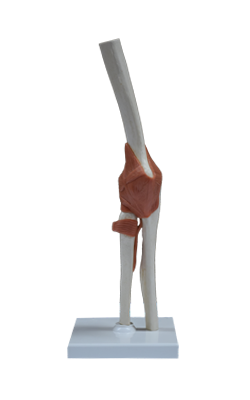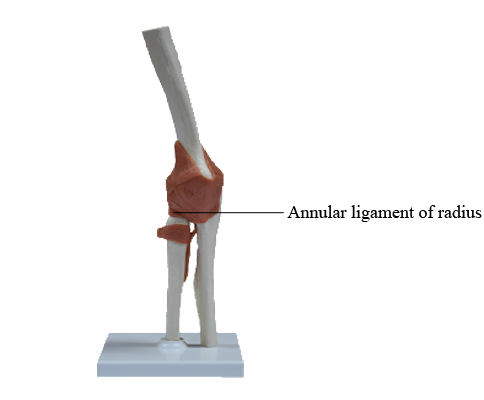Main Model

Anterior : Annular ligament of radius

Elbow Joint
Ligaments of Elbow Joint
The collateral ligaments of the elbow joint are
strong triangular bands that are medial and lateral thickenings of the
fibrous layer of the joint capsule. The lateral, fan-like radial
collateral ligament extends from the lateral epicondyle of the humerus
and blends distally with the anular ligament of the radius, which
encircles and holds the head of the radius in the radial notch of the
ulna, forming the proximal radio-ulnar joint and permitting pronation
and supination of the forearm.
The medial, triangular ulnar collateral ligament
extends from the medial epicondyle of the humerus to the
coronoid process and olecranon of the ulna and consists of
three bands:
(1) the anterior cord-like band is the strongest,
(2) the posterior fan-like band is the weakest, and
(3) the
slender oblique band deepens the socket for the trochlea of
the humerus.
Proximal Radio-Ulnar Joint
The proximal (superior) radio-ulnar joint is a pivot type
of synovial joint that allows movement of the head of the
radius on the ulna.
Articulation of Proximal Radio-Ulnar Joint
The head of the radius articulates with the radial notch of
the ulna. The radial head is held in position by the anular
ligament of the radius.
Ligaments of Proximal Radio-Ulnar Joint
The strong anular ligament, attached to the ulna anterior and
posterior to its radial notch, surrounds the articulating bony
surfaces and forms a collar that, with the radial notch, creates a ring that completely encircles the head of the radius. The deep surface of the anular
ligament is lined with synovial membrane, which continues
distally as a sacciform recess of the proximal radio-ulnar
joint on the neck of the radius. This arrangement allows the
radius to rotate within the anular ligament without binding,
stretching, or tearing the synovial membrane.